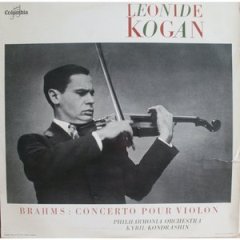The Art Of Leonid Kogan CD 09 - Brahms: Violin Concerto in D major op.77 (2014)
The Art Of Leonid Kogan CD 09 - Brahms: Violin Concerto in D major op.77 (2014)

1. I. Allegro non troppo (20:57) 2. II. Adagio (9:00) 3. III. Allegro giocoso (7:41) Leonid Kogan(violin) Philharmonia Orchestra Kyril Kondrashin(conductor)
It is not known when Brahms began work on his Violin Concerto, but we do know that he finished his first draft during the summer of 1878 at Portschach in southern Austria. He then sent the solo violin part to his long time friend, the composer, conductor, virtuoso violinist, and dedicatee of the concerto, Joseph Joachim. Brahms had for years consulted with him on various compositions, seeking his criticisms and learned opinions. In the note accompanying the violin part, Brahms sought that Joachim should “…correct it, not sparing the quality of the composition and that if you thought it not worth scoring, that you should say so. I shall be satisfied if you will mark those parts which are difficult, awkward, or impossible to play”.
Joachim found the solo to contain “…a lot of really good violin music”. He premiered the work on New Year’s Day, 1879 in Leipzig.
The orchestral exposition of the first movement presents the first theme in the low strings and bassoons, succeeded by a series of chromatically inflected linking passages. Following the orchestral exposition, the violin enters not in D major, but in D minor in an extended quasi-cadenza passage over a sustained tone in the timpani and cellos, as melodic fragments are heard echoing throughout the orchestra. The violin then goes on to introduce a new, lyrical theme that it shares with the orchestra. In the cadenza of the recapitulation, Brahms calls upon the soloist to extemporize, making it the last great concerto in history in which the soloist is asked to do so. [Joachim’s own cadenza is played at these performances.]
The Adagio, in F major, presents a pastoral theme in a setting of woodwinds led by the oboe. The violin enters later, ornamenting the theme over a string accompaniment. The calm ambience gives way to a stormy middle section which eventually winds its way back to the calm of the pastoral setting.
The finale, with its abundance of melodic double-stop writing for the violin, is reminiscent of a kind of gypsy-inspired music. But the great lyricism and rhythmic drive of the themes far transcends any sentiment inferred by such a statement, and the many moods depicted throughout the movement give to this pure orchestral music the universal value of hard-earned human artistic expression. --- Steven Lacoste, laphil.com
download (mp3 @320 kbs):
yandex 4shared mega mediafire cloudmailru oboom uplea








